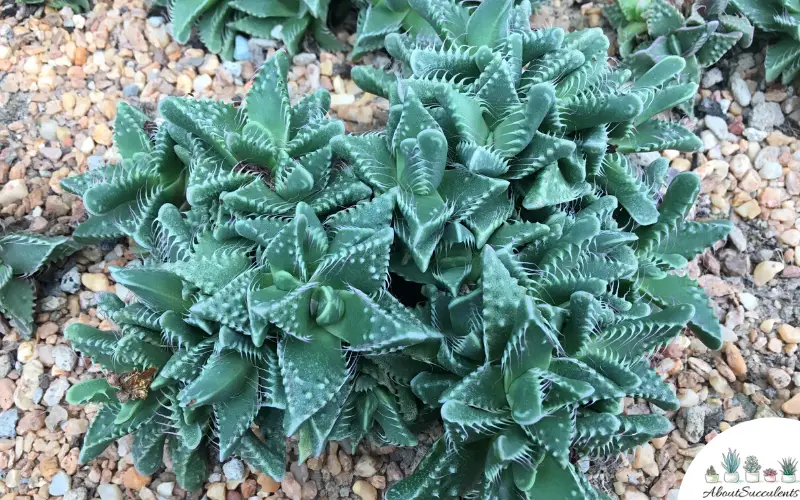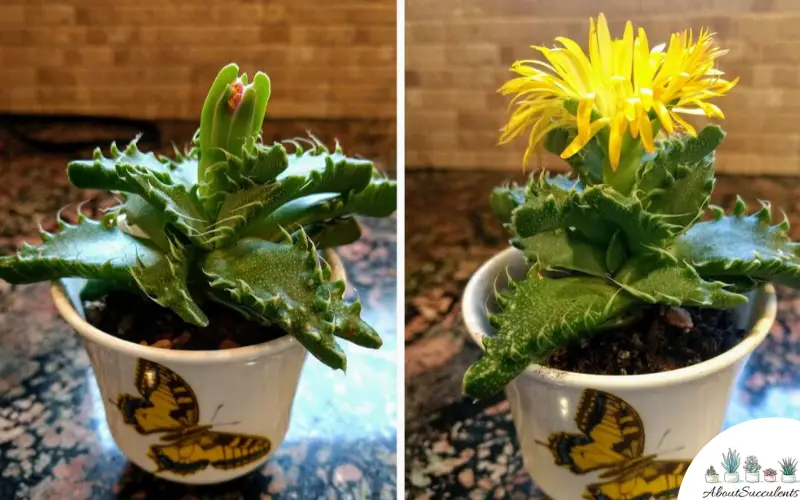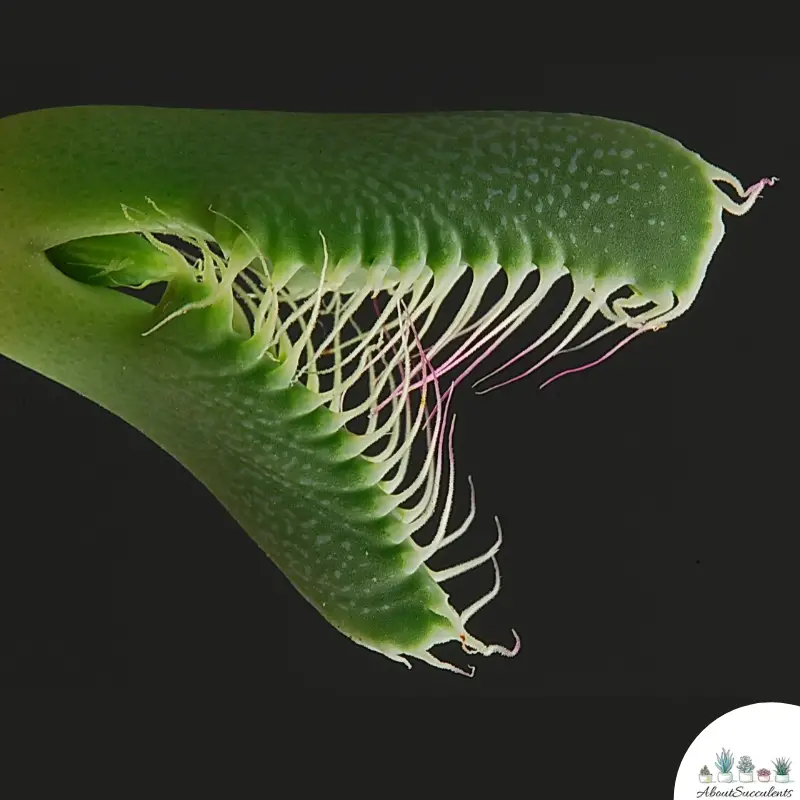
Faucaria Tigrina is a frightful looking succulent that produces yellow flowers. It has jagged, triangular shaped leaves that dribble a white liquid. The succulent’s name is inspired by the leaves that give it an appearance of gaping-wide ravenous jaws. The colors of the leaves will vary depending on its interaction with sunlight. On a given day, the leaves may change from light to dark green to pinkish-red or to deep purple when given enough sunlight. This plant which belongs to the Aizoaceae family is also known as “Tiger’s Jaw”, “Shark’s Jaws”, and “Tierbekvygie”.
Faucaria Tigrina can grow up to 6 inches (15 cm). The plant’s origin is in the Albany Thicket of the Eastern Cape Province in South Africa.
General Information:
Also known as: Tiger’s Jaw, Shark Jaws
Plant Family: Aizoaceae
Origin: South Africa
Height: 6” (15 cm) tall
Exposure: Direct sun exposure for 3 to 6 hours; partial shade in the winter.
Water Needs: Twice-a-day misting; little watering during the winter months.
Soil Type: Cactus potting mix or non-peat based compost with 1 part coarse sand and 2 parts soil.
Soil pH: Low pH (4.7 to 5.7 pH)
Maintenance Requirements: Low
Tolerance: Winter
How to Grow and Care for Faucaria Tigrina / Tiger’s Jaw

Tiger’s Jaw makes an excellent potted plant that grows in the Spring and Fall seasons. Its ideal temperature for growing is 20° C (68° F). If you live in an area with colder temperatures, you will have to plant the succulent in a pot that can be placed indoors.
It’s recommended to grow the succulent in the garden, so that it gets enough sunlight every day. If you plan to keep the plant indoors, note that due to the lack of sunlight, it might not bloom.
Sunlight
Faucaria Tigrina is a sun-loving succulent that needs 3 to 6 hours of sunlight to induce its beautiful, bright-yellow flowers into full bloom. In the wintertime, give Tiger’s Jaw some shade, less time under the sun, and a bit of watering to ensure proper care.
Watering
Before watering the Faucaria Tigrina succulent, allow the soil to completely dry out. When the soil is dry to the touch, give the succulent a thorough watering. This process called the “soak and dry” method should be followed between waterings.
If the succulent does not receive enough water, the stems will die. However, in the wintertime, reduce the frequency of watering as too much water will kill the succulent.
Pot and Soil
Faucaria Tigrina will not survive being immersed in water for a long time. For this reason, buy a pot that has good drainage. The roots of this succulent are quite small which means you can plant them in a shallow pot.
Keep in mind that the roots will grow with time and this means you might have to repot the succulent in a bigger container.
A standard cactus potting mix has all the important nutrients in the soil to support the needs of Faucaria Tigrina.
A combination of 2 parts loam, 1 part coarse sand, and 1 part pumice is highly recommended to keep the succulent free of pests such as red spiders and burrowing insects.
How to Propagate Faucaria Tigrina

Faucaria Tigrina is an excellent succulent plant for novice growers. Propagating the Tiger’s Jaw can be a delightful and enriching experience for those interested in taking up succulents as a hobby.
Faucaria Tigrina is considered a self-sufficient succulent and does not need additional care.
Soil Method
Step 1: Before preparing the soil mixture, set aside a few small pots that measure 60mm x 60mm and have good drainage.
Step 2: The recommended soil mixture for Faucaria Tigrina is composed of 2 parts sterilized potting soil, 1 part pumice which is sieved to 3mm, and 1 part sand.
Step 3: Once you have the components, heat them at a temperature of 70°C (158°F) then leave them for 1 week.
Step 4: When the soil mixture is ready, place it in the 60mm x 60mm pots.
Step 5: After you’ve sowed the seeds of Tiger’s Jaw, top it with river sand. It should be no deeper than the length of the succulent seeds.
Step 6: Use distilled water when soaking the pots then cover the top with a sheet of transparent plastic. This will create a moist environment that is needed to produce germination.
Step 7: After 4 days, loosen the plastic cover and on the 7th day, discard the cover completely. You will see the seedlings emerge during this period.
Step 8: To water the seedlings properly, dilute a small amount of fertilizer with water and use a sprayer to create a fine mist. The seedlings must be watered with fine mist twice a day.

Leaves Cutting
Step 1: When using the leaves cutting method for propagation, it is advisable to remove the cuttings in Spring.
Step 2: Before placing the cuttings into the soil, allow them to dry for a few days.
Step 3: With the leaves cutting method, use a soil mixture composed of potting soil and sand. Make sure there is ample heat source at the bottom of the pot.
Step 4: Place the cuttings under shade to spur proper rooting and growth.
Frequently Asked Questions
Faucarina Tigrina and its variations Tiger’s Jaw and Shark Jaws are not included in the American Society for the Prevention of Cruelty to Animals (ASPCA) list of plants that are toxic to cats and dogs.
The Faucaria Tigrina plant might be dying because of underwatering, overwatering, infestation or fungal infection. Read more about each causes below.
Underwatering
If Faucaria Tigrina does not receive enough water, the stems will die. Keep in mind that its rosettes meet at the base but are not connected to the roots. However, if you can find the rosettes in time, you can use them as cuttings.
The succulent should be watered using a fine mist solution of water and diluted fertilizer twice a day except during the winter season.
Overwatering
In the winter season, Faucaria Tigrina becomes dormant. Thus, it should not receive as much water. The purpose of watering at this time is to keep off red spiders and to clean the leaves.
Infestation
Red spiders and burrowing insects are the natural enemies of Tiger’s Jaw. Twice-a-day misting will keep red spiders away while the addition of grit into the soil mixture will protect the succulent from burrowing insects.
Fungal Infection
Consistent watering and excellent air circulation will prevent Faucaria Tigrina from developing a fungal infection.
However, if infection should develop, remove the rotting parts to keep the disease from spreading.
Faucaria Tigrina produces beautiful flowers that are bright yellow in color and have elegant-looking petals – long and slim. Its flowers will bloom during the fall to early winter months.
To ensure the growth of the flowers, Tiger’ Jaw should receive between 3 and 6 hours of direct sunlight per day.
You will see the flowers open at midday and close up by nightfall.
Last Updated on June 10, 2022 by Sofia Lara